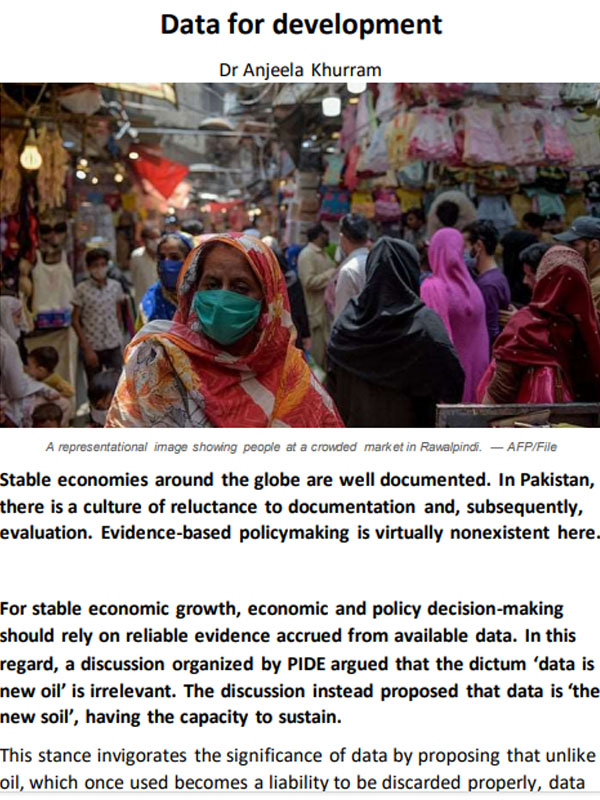
Pakistan Institute of Development Economics
- Home
Our Portals
MenuMenuMenuMenuMenuMenuMenu - ResearchMenuMenuMenuMenuMenuMenuMenu
- Discourse
- The PDR
- Our Researchers
- Academics
- Degree Verification
- Thesis Portal
- Our Portals
Data for development
Stable economies around the globe are well documented. In Pakistan, there is a culture of reluctance to documentation and, subsequently, evaluation. Evidence-based policymaking is virtually nonexistent here.
For stable economic growth, economic and policy decision-making should rely on reliable evidence accrued from available data. In this regard, a discussion organized by PIDE argued that the dictum ‘data is new oil’ is irrelevant. The discussion instead proposed that data is ‘the new soil’, having the capacity to sustain.
This stance invigorates the significance of data by proposing that unlike oil, which once used becomes a liability to be discarded properly, data behaves like ‘soil’, providing a fertile medium to learn, experience and make good decisions. The inclusive use of data can eventually lead to sound decision-making for the optimal use of resources to reap the benefits effectively. Generally, public-sector organizations use the data solely to justify the need for identification for certain projects in education, infrastructure, health, security and other sectors.
Data availability/sharing for policymaking and performance evaluation can ensure accountability, leading to the transparency (good governance) of the system.
Though data-based decision-making renders the process transparent, public and private organizations in Pakistan have no appetite for transparency — neither in their results frameworks nor in their governance mechanisms. They are by default defiant of accountability and transparency. The availability of data does not ensure its use for policymaking.
The availability of reliable data can initiate good policymaking, but this does not serve as an end in itself. It is rather a starting point to achieve the objectives of the policy effectively. Planning done in the absence of data can hinder the achievement of excellence in national growth.
How data availability can set the direction for bringing stability to Pakistan needs to be focused on. For healthy economic and policy decision-making, data availability should be ensured. For instance, data can help identify the actual match or mismatch between the demand and supply sides to accurately identify the need.
Similarly, data from the census helps determine the budget share; the job quota; and the number of national and provincial assembly seats proportional to the population size of provinces. Demographic profiling can back good policymaking regarding public investment decisions in many sectors. For example, information about the concentration of the education level of a specific cohort of male or female students (demand side) can be snapped on the map against the number of schools (supply side) to identify the need for more investment.
To foster a culture of transparency, accountability, and good governance, the availability of digital data can be a starting point for the government — both federal and provincial — to cultivate the results effectively and efficiently. To curtail the probability of corruption, it is necessary to hold stakeholders accountable to ensure transparency. One way is to have some benchmarks embedded in the policy backed by evidence to evaluate the process and its effectiveness.
But the alarming situation is the absence of a results framework. The lack of transparency behind this can either be due to the non-availability of data or an inclination not to use the current data for personal gain. To add fuel to the fire, the government lacks the deliberation to vet the credentials against data to hold the stakeholders accountable. The non-availability of data holds no one accountable, thus, escaping transparency.
Therefore, the need is to put in place a results framework, containing identified parameters to measure the outcomes of publicly financed projects in the realm of health, education, etc. Even the availability of the data is marred by its dissemination format. Data visualization can make findings accessible, appealing and comprehensible to the audience. Instead of voluminous reports with dozens of figures and tables, which are destined to be shelved, data should be made available in interactive modes to be absorbed readily.
The use of data for evidence-based public policy is rare in the public and private sectors. Generally, data is used to justify the need for investments in the public sector. The sectors are reluctant to provide data about the performance of their ongoing and completed projects for evaluation. Their corruption, nepotism, and personal interests are some of the factors counting for their fear of evaluation.
Political interference and politicizing the issues are some other factors hindering the organization from sharing their information. This attitude has corroded national institutions, making them corrupt and inefficient. This is an alarming situation. At this juncture, it is the responsibility of academia and researchers to explore the data to check the health of the prevalent policies for improvement. Policymakers should embrace constructive feedback to promote transparency.
Copyright The News, 2024
The writer is a Research lecturer at the Pakistan Institute of Development Economics (PIDE), Islamabad.
She posts on X: @KhurramAnjeela



